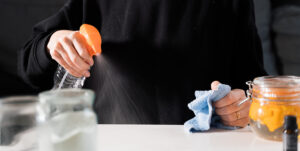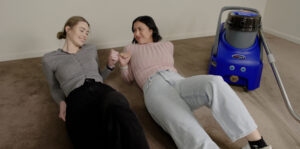Tile Floor Cleaning Guide for All Types (Including Grout!)
While a Britex 3in1 Deep Cleaning Machine can come with a Grout & Tile attachment perfect for tiled floors in kitchens, bathrooms and laundries, the more that you maintain your tile floors and keep them clean, the less you’ll need to hire a Britex! Maintaining the cleanliness of your tile floors and grout is crucial. Follow these effective cleaning techniques to ensure your tiles and grout always look fresh and new.
Cleaning Ceramic and Porcelain Tile Floors
Ceramic and porcelain tiles can be quite durable but following a few simple cleaning tips will keep them sparkling. Here’s how to clean tile floors made of ceramic and porcelain:
- Remove loose debris: Regularly sweep or vacuum your tile floors to prevent them from becoming dull. While ceramic tiles are resistant to dirt, sand and grit can dull their glazed surfaces.
- Choose the right mop: Opt for a rag mop instead of a sponge mop when cleaning tile floors. Use mild detergent and clean water. Sponge mops typically push dirty water into the grout lines, making them more difficult to clean.
- Address tile stains: If you notice any discoloration, identify the cause and select an appropriate cleaner for effective stain removal.
- Eliminate soap residue: In case your tiles appear hazy after cleaning, it might be due to soapy residue. Remove the film using a nonabrasive all-purpose cleaner. For ceramic or porcelain tiles, you can also try a homemade cleaner made with fresh lemon juice (avoid using on stone tiles).
- Dry the tiles: Avoid letting your glazed tile floors air-dry, as this can result in water spots. Instead, promptly dry the floor with a clean, lint-free cloth after washing.
Cleaning Stone Tile Floors
When dealing with natural stone tiles like slate, granite or marble, it’s important to handle them with care. Harsh cleaners can damage the surface of these materials. Follow these instructions to clean stone tile floors effectively:
- Slate Tile: If your slate tiles are not coated, you may use a mild detergent, as long as it doesn’t contain acidic properties like lemon or vinegar. To prevent water spots, dry the tile immediately with a soft towel.
- Marble Tile: Marble tiles are visually stunning but require high maintenance. Avoid cleaning them with acidic solutions or substances, such as lemon or vinegar, as they can etch the tile’s surface. Also, steer clear of brushes with tough bristles or scouring powders that may scratch the marble.
- Granite Tile: Clean granite tile with a mild pH-neutral detergent, similar to slate and marble tile. Harsh cleaners may leave streaks or cause discoloration. For polished granite floors, consider buffing them to maintain a shiny and clean appearance.
Cleaning Resilient Tile Floors
Resilient tile, including linoleum, vinyl, cork, and rubber, is an excellent choice for a low-maintenance and comfortable surface. Keep the following tips in mind when cleaning your resilient tile floors:
- Vinyl Tile: This highly resilient flooring type is easy to maintain. Regularly sweep or vacuum debris and mop with a vinyl cleaning solution or a mixture of water and vinegar. Avoid using abrasive cleaners or scrubbing tools that may scratch the surface.
- Linoleum Tile: Although often confused with vinyl flooring, linoleum has distinct cleaning requirements. After sweeping or vacuuming, wash linoleum tile with a linoleum flooring cleaning solution before rinsing thoroughly and allowing the floor to dry. To protect your linoleum, apply a coat of wax and buff every 3 to 6 months.
- Cork Tile: Cleaning cork tile floors depends on the finish. If the cork surface is sealed with polyurethane (most cork floors are), clean it with water and mild detergent or white vinegar, and rinse well. For unfinished or waxed cork, follow the cleaning instructions for polyurethane and apply solid or liquid wax once the tile is dry.
Cleaning Tile Grout
Clean grout is the secret to achieving a fantastic-looking tile floor. Since grout is porous and can absorb grease and stains, proper cleaning is essential. Follow these steps to restore your grout to its original appearance:
- Create a DIY grout cleaner: Instead of using commercial cleaners, make a paste by mixing baking soda and water.
- Scrub the grout: Apply the paste to the stained grout, let it sit overnight, and then scrub it in the morning using a stiff nylon brush. Avoid using a metal brush which could damage the grout. Repeat the process if necessary.
- Seal the grout: Apply a silicone-based sealer to the grout to prevent future stains. This technique is most effective when applied 2 weeks after the grout is installed.
Frequency of Tile Floor Cleaning
To maintain clean and residue-free tile floors, follow this recommended dry and wet cleaning schedule:
- Dry cleaning: Vacuum or sweep your tile floors at least once a week, or whenever you notice visible debris. While a soft-bristle vacuum attachment works well on any type of tile floor, it may be challenging to reach corners or tight spaces. Use a hand broom and dustpan to complete the job.
- Wet cleaning: Plan to mop your kitchen tile floor every two weeks and your bathroom tile floor once a week (as germs tend to accumulate in bathrooms). Spot-clean your grout every few months or whenever it appears dull.
By following these guidelines, you can keep your tile floors and grout looking their best, regardless of the material used. Of course, if you don’t, you can get that Britex Clean Feeling yourself thanks to our Britex 3in1 Deep Cleaning Machine and its Grout & Tile Attachment. Find your nearest hire location today and bring your tiles back to life!

10 Carpet Cleaning Myths We’re Putting to Rest, Once and For All.
While vacuuming the visible crumbs is a great start for your carpet, believe it or not, it’s not a one stop solution. That’s just one

We Tried the CleanTok Hacks Everyone’s Talking About in 2025
Let’s face it, CleanTok has a hold on us. One second you’re checking the weather, next thing you know it’s midnight and you’re watching someone

The No-Drama Cleaning Rota That’ll Save Your Sharehouse
Living in a sharehouse can be the best of times: impromptu dinners, late-night chats, someone always around to water your plants. But nothing sours the

Five Mud-Busting Methods to Keep your Flooring Spick & Span in Winter
Rainy days might be good for the garden and a Netflix binge, but your floors? Not so much. Wet umbrellas dumped just about anywhere, plus
